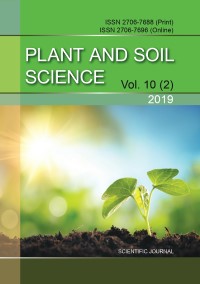PRORORTION CRUDE PROTEIN IN ALFALFA-GRASS MIXTURES DEPENDING ON THEIR SPECIES COMPOSITION AND MINERAL NUTRITION LEVEL UNDER STEPPE RIGHT BANK UKRAIN
DOI:
https://doi.org/10.31548/agr2019.02.048Keywords:
вміст гумусу, лабільна органічна речовина, родючість ґрунту, система удобрення, попередникAbstract
The results of researches on the influence of organic and mineral fertilizers on the accumulation of general humus and mobile (labile) organic matter in typical chernozem are presented. The introduction of fertilizers for the cultivation of winter wheat in field short-rotation crop rotation after various predecessors (winter rape and soybean) contributed to the change in the content of labile forms of humus. The smallest amount of labile organic matter is removed from the soil of the control variant at the level 146-165 mg/100 g of soil. Application of mineral fertilizers only increases the moving humus substances, increasing their content was observed in super intensive and intensive fertilizer systems where their content was 20-35 % higher relative to the resource-saving fertilizer system and 1.5-2.0 times higher than control.
The cultivation of winter wheat on the background of Nо-till technology is an economical soil tillage system and resulted in an increase in the content of labile organic matter in the arable layer by 4-7 % relative to the classical cultivation.
References
Mamontov, V. G., Afanas'eva, R. A, Rodionova, L. P., Bіkanova, O. M. (2007). K voprosu o labіl'nom organіcheskom veshchestve pochv. [Тo the question about the labile organic matter of soils] Plodorodie. (2) 20-22. [in Russian].
Tonkha, O. L. (2010). Biological activity of Chernozem under nature reserve "Mykhailivska Tsilyna" and agricultural use New developments in research and management of the world's mollisoil Harbin, China, 165-166.
Pikovska, O. V, Vitvitska, O. I. (2016). Vplyv zastosuvannya solomy na pokaznyky rodyuchosti chornozemu typovoho. [Influence of straw application on fertility indexes of typical chernozem]. Naukovyy visnyk Natsionalʹnoho universytetu bioresursiv i pryrodokorystuvannya Ukrayiny. Seriya : Ahronomiya, 235, 160-166. URL: http://nbuv.gov.ua/UJRN/nvnau_agr_2016_235_21
Orlov, D. S. (1981). Praktikum po khimii gumusa. [Workshop on the humus chemistry]. M.: MGU, 273. [in Russian].
Lykov, A. M. (1985). Gumus i plodorodie pochvy . [Humus and soil fertility]. Moscow: Rabochyi, 192. [in Russian].
Mazur, H. A. (2002). Humus i rodiuchist hruntu. Ahrokhimiia i hruntoznavstvo: mizhvid. tem.zb. . [Humus and soil fertility. Soil Science and Agrochemistry on the Way to Sustainable Development of Ukraine]. Kharkiv, (1), 27-33. [in Ukrainian].
Rozkoshanskii, A. D. (1976). Pozhnivno-kornevye ostatki i ikh rol' v izmenenii uslovii pochvennogo plodorodiya . [Stubble-root residues and their role in changing soil fertility conditions]. Agrokhimiya. (1), 95-100 [in Russian].
Balayev, A. D. Pikovska, O. V, Tonkha, О. L. (2018). Vmist humusu ta labilnux orhanichnux rechovyn za riznogo vukorustannj chornozemu typovoho [Content of humus and labile organic matter in different use of chernozem typical]. Naukovyy visnyk Natsionalʹnoho universytetu bioresursiv i pryrodokorystuvannya Ukrayiny. Seriya : Ahronomiya, 286, 173-179.
Rusakova, I. V. (2009). Soderzhanie i kachestvennyi sostav gumusa dernovo-podzolistoi pochvy pri dlitel'nom primenenii solomy zernovykh i zernobobovykh kul'tur. . [Сontent and qualitative composition of humus of sod-podzolic soil when longening the application of straw grain and leguminous crops]. Agrokhimiya. (1), 11-17. [in Russian].
Sharkov, I. N. (1987). Udobrenie i problema gumusa v pochvakh. [Fertilizers and the problem of humus in soils]. Pochvovedenie. (11), 70-81. [in Russian].
Downloads
Published
Issue
Section
License
Relationship between right holders and users shall be governed by the terms of the license Creative Commons Attribution – non-commercial – Distribution On Same Conditions 4.0 international (CC BY-NC-SA 4.0):https://creativecommons.org/licenses/by-nc-sa/4.0/deed.uk
Authors who publish with this journal agree to the following terms:
- Authors retain copyright and grant the journal right of first publication with the work simultaneously licensed under a Creative Commons Attribution License that allows others to share the work with an acknowledgement of the work's authorship and initial publication in this journal.
- Authors are able to enter into separate, additional contractual arrangements for the non-exclusive distribution of the journal's published version of the work (e.g., post it to an institutional repository or publish it in a book), with an acknowledgement of its initial publication in this journal.
- Authors are permitted and encouraged to post their work online (e.g., in institutional repositories or on their website) prior to and during the submission process, as it can lead to productive exchanges, as well as earlier and greater citation of published work (See The Effect of Open Access).

